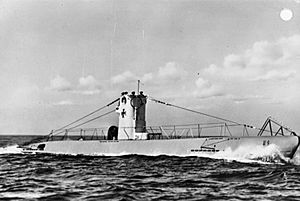German submarine U-12 (1935) facts for kids

U-9, a typical Type IIB boat
|
|
Quick facts for kids History |
|
|---|---|
| Name | U-12 |
| Ordered | 20 July 1934 |
| Builder | Germaniawerft, Kiel |
| Yard number | 546 |
| Laid down | 20 May 1935 |
| Launched | 11 September 1935 |
| Commissioned | 30 September 1935 |
| Fate | Sunk 8 October 1939 in the English Channel near Dover. 27 dead |
| General characteristics | |
| Class and type | IIB coastal submarine |
| Displacement |
|
| Length |
|
| Beam |
|
| Height | 8.60 m (28 ft 3 in) |
| Draught | 3.90 m (12 ft 10 in) |
| Installed power |
|
| Propulsion |
|
| Range |
|
| Test depth | 80 m (260 ft) |
| Complement | 3 officers, 22 men |
| Armament | |
| Service record | |
| Part of: |
|
| Identification codes: | M 17 865 |
| Commanders: |
|
| Operations: | One |
| Victories: | No ships sunk or damaged |
The German submarine U-12 was a U-boat built for Nazi Germany's navy, called the Kriegsmarine. It was a Type IIB submarine. Its construction began on 20 May 1935 at Germaniawerft in Kiel, Germany. The submarine officially joined the navy on 30 September 1935.
About the U-12 Submarine
The U-12 was a German Type IIB submarine. These submarines were a bit larger than the very first Type II models. When on the surface, U-12 weighed about 279 tonnes. When it was underwater, it weighed about 328 tonnes.
Size and Power
The submarine was about 42.7 meters (140 feet) long. Its main body, called the pressure hull, was about 28.2 meters (92.5 feet) long. The U-12 was powered by two diesel engines when on the surface. These engines provided 700 horsepower. When underwater, it used two electric motors, which gave it 460 horsepower.
The U-12 had two propellers to help it move. It could travel up to 12 knots (about 22 kilometers per hour) on the surface. Underwater, its top speed was 7 knots (about 13 kilometers per hour). The submarine could dive to depths of up to 80 meters (262 feet).
Weapons and Crew
The U-12 was equipped with three torpedo tubes at the front. It could carry five torpedoes. Instead of torpedoes, it could also carry up to 12 or 18 naval mines. These mines were used to damage enemy ships. The submarine also had a 2 cm anti-aircraft gun. This gun was used to defend against airplanes. The crew of the U-12 consisted of 25 people.
The Fate of U-12
The U-12 was sunk on 8 October 1939. It hit a mine near Dover in the English Channel. The exact spot where it sank is not known, but it was around 51°10′N 01°30′E. Sadly, all 27 crew members on board died. The body of its commanding officer, Dietrich von der Ropp, was found later. It washed ashore near Dunkirk, France, on 29 October 1939.
In 2002, the German government suggested that the wreck of U-12 should be a "protected place." This means it would be safe under the Protection of Military Remains Act 1986. This law helps protect military wrecks in UK waters. The U-12 was chosen to represent all other German submarines lost in that area.
See also
 In Spanish: U 12 (1935) para niños
In Spanish: U 12 (1935) para niños

